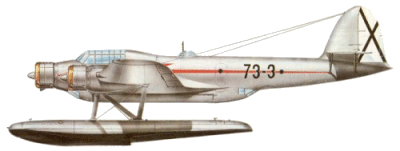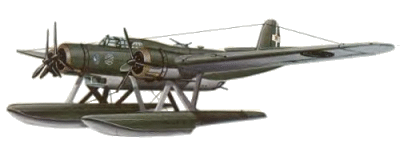
In July 1935 there flew
the prototype of a large wooden twin-float-seaplane, powered by three
840 hp (626 kW) Isotta-Fraschini Asso XI inline engines. This was the
CRDA Cant Z.505 which had been designed as a mail-plane. On 19 August
in the same year, Mario Stoppani conducted the first flight of the
slightly smaller and lighter Z.506, a 12/14-passenger transport with
three 610 hp (455 kW) Piaggio Stella IX radial engines. The type was
put into production in 1936 as the Z.506A, and entered service with the
Italian airline Ala Littoria during that year on routes around the
Mediterranean. Powered by three 750 hp (559 kW) Alfa Romeo 126 RC.34
radial engines the Z.506A, flown mostly by Mario Stoppani, set several
altitude, distance and speed records in 1936-8, including speeds of
191.539 mph (308.25 km/h), 198.7 mph (319.78 km/h) and 200.118 mph
(322.06 km/h) over distances of 3,107 miles (5000 km), 1,243 miles
(2000 km) and 621 miles (1000 km) respectively. It carried a payload of
4,409 lbs (2000 kg) to 25,623 ft (7810 m) and 11,023 lbs (5000 kg) to
22,693 ft (6917 m) and later flew 3,345.225 miles (5383.6 km) over a
closed circuit.
A military version,
designated Z.500B Airone (Heron), was shown at the Milan Aeronautical
Exhibition in October 1937. This had a stepped, extensively glazed
tandem two-seat cockpit and a ventral gondola which contained the bomb
aimer's position and the bomb bay, immediately behind which was a
gunner's position. The Z.506B was built at Cant's Monfalcone and Finale
Ligure Factories, and by Piaggio under licence. In November 1937 a
Z.506B with 750 hp (559 kW) Alfa Romeo 127 RC.55 engines set a
load-to-height record of 33,318 ft (10155 m) with a 2,205 lbs (1000 kg)
payload, and then flew 4,362 miles (7020 km) non-stop from Cadiz to
Carevalas. Z.506 variants included an air-sea rescue Z.506S of which at
least 20 were produced as conversions from Z.506Bs, and a single Z.506
landplane which was specially prepared with fixed, spatted landing gear
for an endurance record attempt by Mario Stoppani; this was at first
postponed, then finally cancelled, because of continuing bad weather.
In 1936 a heavy bomber prototype, which was essentially a scaled-up
version of the Z.506, was built under the designation Z.508. No
production version resulted but this aircraft, powered by three 840 hp
(627 kW) Isotta-Fraschini Asso XI RC.40 engines, was used to set a
number of records, including a speed of 154.26 mph (248.25 km/h) over a
1,234 mile (2000 km) course with an 11,023 lbs (5000 kg) payload.

A Cant Z.506B Airone "Heron" of Grupo No. 73 of the Agrupacion Espanola
based at Majorca in 1939
Last of this family was
the Z.509, a larger and heavier version of the Z.506A of which three
were built in 1937 for use on Ala Littoria's transatlantic postal
service to South America. This model was powered by three Fiat A.80
RC.41 radial engines, and a new wing of 92 it 11 in (28.32 m) span and
1,076.43 sq it (100.00m2) area was introduced to compensate for
increased empty and maximum take-off weights of 22,000 lbs (9980 kg)
and 35,200 lbs (15965 kg) respectively. Production of the Z.506B
totalled 324, including two prototypes which were supplied to the Regia
Aeronautica and the Regia Marina; the latter service took over 29
aircraft, the balance of a Polish order for 30 which were not delivered
as a result of the German invasion. Five were delivered to the
Nationalist forces in the Spanish Civil War late in 1938. A number of
the Z.506S air-sea rescue aircraft remained in service until 1959.
The Largest float
seaplane to give wide spread operational service during World War II
(although the Junkers Ju 52/3mW might also lay claim to this
achievement), the Italian Cant Z.506B Airone (Heron) three engine
twin-float reconnaissance bomber was developed from the commercial
Z.506A in 1936, production of the military aircraft starting the
following year with a batch of 32 aircraft (Serie I) and differing from
the earlier aircraft in featuring a long ventral gondola accommodating
bomb bay, bomb-aimer's station and a rear ventral gun position. A
semi-retractable gun turret was also added.
The early Z.506B
aircraft were evaluated with the Aviazione Legionaria in Spain during
1939, 30 other aircraft having also been ordered by the Polish naval
wing (in the event only one of the latter had arrived in Poland when
the Germans invaded in September, and the remaining aircraft were taken
on charge by Italy's Regia Marina). By the date of Italy's entry into
the war in June 1940 the Z.506B was in full production, 95 aircraft
having been completed by the parent company. Most of these were serving
with the 31° and 35° Stormi Bombardamento Marittimo at Elmas and
Brindisi respectively were these units were fairly heavily engaged
during the campaign in Greece, although they seldom operated when
likely to be opposed by RAF fighters. They participated in the capture
of Corfu, Cefalonia and Zante, and attempted to shadow British naval
forces after the Battle of Cape Matapan but sheered away when faced by
Fleet Air Arm Fairey Fulmar fighters. Thereafter the "Airone" was
almost entirely withdrawn from use as a bomber and torpedo attack
aircraft, the Italian navy calling for its greater use in maritime
reconnaissance, air-sea rescue, convoy escort and anti-submarine patrol
roles; such had been the shift in naval superiority in the
Mediterranean following the debacle at Taranto and the Battle of Cape
Matapan.
Development and
production of the Airone continued, with small modifications being
introduced with each new production batch (serie), of which Serie XII
was the most important. A special air-sea rescue conversion was the
Z.506S (Soccorso), this version being also used in small numbers by the
Luftwaffe. After the Italian surrender 23 Z.506B and five Z.506S
aircraft were flown to Allied ports and subsequently flew with the
Co-Belligerent Air Force's Raggruppamento Idro, performing transport
and other second-line tasks.

A Cant Z.506B Airone "Heron" of the Stormi Bombardamento Marittimo
early 1943
Cant Z.506B - This was
a militarised version featuring a stepped, extensively glazed tandem
two-seat cockpit and a ventral gondola which contained the bomb aimer's
position and the bomb bay, immediately behind which was a gunner's
position with a single 7.7 mm (0.303 in) Breda-SAFAT machine-gun. A
12.7-mm (0.50 in) gun was fitted in the Breda M.1 upper turret. The
bomb bay could accommodate an 1,764 lbs (800 kg) torpedo or a
combination of smaller weapons to a similar total weight, while later
versions were able to carry a bomb load of 2,645 lbs (1200 kg) and were
equipped with two 7.7 mm (0.303 in) Breda-SAFAT machine-guns in waist
positions and a Caproni-Lanciani Delta E turret replacing the Breda
turret. The Z.506B was built at CANT's Monfalcone and Finale Ligure
factories, and by Piaggio under licence.
Cant Z.506S Soccorso -
A dedicated air-sea rescue version, including 20 Z.506Bs converted by
Savoia-Marchetti in 1948.
Cant Z.506 Landplane -
One Z.506 was specially prepared for an endurance record attempt by
Mario Stopparii, and was converted to a landplane configuration with
fixed, spatted landing gear. The flight was at first postponed and then
cancelled as a result of continuing bad weather.
Cant Z.508 - A 1936
heavy bomber prototype, essentially a scaled-up version of the Z.501.
Data included a powerplant of three 840 hp (627 kW) Isotta-Fraschini
Asso XI RC.40 engines, with a maximum speed of 196 mph (315 km/h), span
30 m (98 ft 5 in) and length 21.45 m (70 ft 5 in). This sole example of
the type set several records, including the carriage of a 22,046 lbs
(1000 kg) load to 6,560 ft (2000 m) and a speed of 154.26 mph (248.25
km/h) over a 1,243 mile (2000 km) course with a 11,023 lbs (5000 kg)
load.
Cant Z.509 - Three
aircraft of this larger and heavier version of the Z.506A were built in
1937 for Ala Littoria's transatlantic postal service to South America,
powered by three Fiat A.80 RC.41 radial engines and with a new wing of
92 ft 11 in (28.32 m) span and 1,076.43 sq ft (100 sq m) area to
compensate for increased empty and maximum take-off weights of 22,000
lbs (9980 kg) and 35,200 lbs (15965 kg) respectively.
(Cant Z.506B Airone
"Heron")
Type: Five Seat
Torpedo Bomber, Reconnaissance Bomber & Rescue Flying Boat
Design: Chief
Engineer Filippo Zappata of Cantieri Riuniti dell'Adriadtico (CRDA) or
Cant
Manufacturer:
Cantieri Riuniti dell'Adriadtico (CRDA) or Cant
Powerplant:
(Z.506B) Three 750 hp (559 kW) Alfa Romeo 126 RC.34 9-cylinder
air-cooled radial engines driving three blade metal propellers.
Performance:
Maximum speed 227 mph (365 km/h) at 13,120 ft (4000 m); cruising speed
202 mph (325 km/h); service ceiling 26,245 ft (8000 m).
Range: Maximum
range 1,705 miles (2745 km) with normal loadout.
Weight: Empty
18,298 lbs (8300 kg) with a maximum take-off weight of 27,117 lbs
(12300 kg).
Dimensions: Span
86 ft 11 1/4 in (26.5 m); length 63 ft 1 3/4 in (19.25 m); height 24 ft
3 1/4 in (7.4 m); wing area 936.49 sq ft
(87.0 sq m).
Armament: One
7.7 mm (0.303 in) Breda-SAFAT machine-gun in the rear gunner position
and a single 12.7 mm (0.50 in) machine-gun in a Breda M.1 turret, plus
a 1,764 lbs (800 kg) torpedo or about the same weight in smaller
ordnance. Later model aircraft carried two 7.7 mm (0.303 in)
Breda-SAFAT machine-guns in waist positions, plus up to 2,645 lbs (1200
kg) of bombs or a single torpedo.
Variants: Z.506,
Z.506A, Z.506 B Airone, Z.506S Soccorso, Z.506 Landplane, Z.508 (heavy
bomber prototype), Z.509 (three civil aircraft).
Avionics: None.
History: First
flight 19 August 1935; (Z.506A) entered production 1936.
Operators: Italy
(Regia Aeronautica, Aeronautica Cobelligerante del Sud, Aeronautica
Nazionale Repubblicana), Germany (Luftwaffe - from an original order of
30 aircraft to Poland).
Units: 31° and 35°
Stormi Bombardamento Marittimo (Maritime Bombardment Squadrons) at
Elmas and at Brindisi respectively.
|
